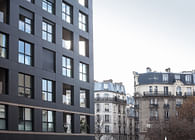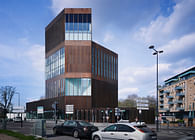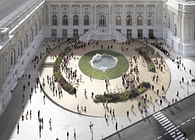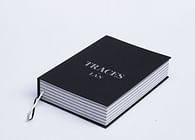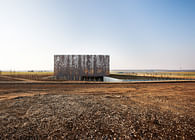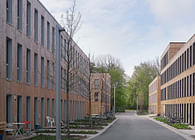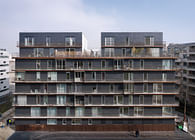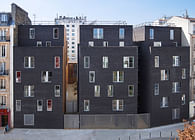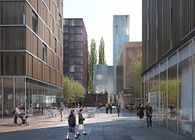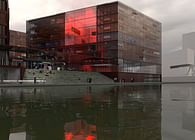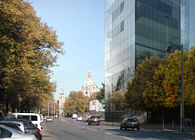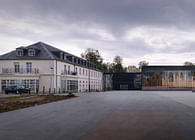
Paris, FR
The starting point of the project was to imagine Beirut in all its complexity. We have imagined the city as an ‘un-finished’ superposition of histories, contexts, architectures and situations. Our project was conceived as an interface, an algorithm that generates new connections and that creates new view axis, ways of observing the history, the present and the future. This wish has been traduced in three different approaches, corresponding to the program demands as to the diverse scale units of the project. 1. The topographical / territorial and spatial scenery: the BASIS The project is located in proximity of the Marina and Solidere district, alongside Omar Daouk and Fakhreddine Street, a zone marked by its high-rise buildings. The study and analyse of the urban adjoining context showed us the importance of the existing green character of our plot. It is the exclamation point of an important green belt originating at the International College of Beirut. The lack of public spaces and more over green open spaces in Beirut inspired us to sublime the green character through our project. Our answer consists in resolving different conflicting elements being the pedestrian flow coming from the port and the significant car traffic on Fakhreddine Street, this on top of the height difference of the plot, 8 meters approximately. The BASIS is a direct result of the existing topography of the plot, creating a banded pattern from east to west. By connecting the different altimetry boarding the plot, several green strips are created which shelter three levels of retail, corresponding to the levels 00.00, 04.00 and 08.00 m connected to the north, east and west plot limit respectively. The three levels of the BASIS are composed of 10 000 m² commercial area, consisting in 9 different retail units with a variable surface from 300 up to 1200 m². Combining public roof garden, retail gallery and pedestrian passage, the various spatial answers add up to an entity at the scale of the pedestrian inspired by existing urban morphologies of Beirut. The levels are vertically connected by voids and skylights incorporated in the green strips and passageways, permitting light and views to cross. The BASIS is a genuine interface between the different elements composing the project. The CLUSTER HOUSES, sheltering 35.000 m² of residential area, are anchored in the BASIS hatched according to its banded pattern. Their volumetry and position is axed on three elements, light, views and scale. The higher part of the cluster shifts backwards to adapt to the scale of the BASIS and building restrictions. From the CLUSTER HOUSES the BASIS is seen as a green carpet, an important quality in terms of view especially for the residences situated on the lower floors of the cluster houses. 2. The continuity of housing typology: the CLUSTER HOUSES The residential part is the most important program unit and without a doubt the most fundamental event of our reasoning. We wanted to realise a continuity of typology as to the traditional oriental patio house, with its rich relation between interior and exterior, and this in a vertical type of building. We have applied this concept on two levels, the interior / scale of the apartment, and the exterior / building scale. This housing type, structured around a central patio assuring a natural ventilation and distribution of the different living units, and so this indoor-outdoor succession has been the starting point for the CLUSTER HOUSES. Each apartment (one, max. two per floor) is entered through an exterior space, the lobby in direct contact with the core’s noble access, dividing the floor in day and night program units. The day units, living and dining area are again separated by a patio. A particular attention has been paid to these special indoor-outdoor sequences, permitting the apartment to morph from winter to summer by a double skin. The interior glazing draws the inner perimeter of the apartment shaping patio and lobby. The glazed walls of these in-between spaces open unconventionally by revolving against the ceiling, this way opening the day zone completely to the exterior. The exterior skin realised in Ductal, includes the structure permitting the interior to be free of any columns and therefore even more generous. This skin is at times completely open, at times perforated by different patterns, permitting light to cross and draw beautiful shadows. The structural mineral envelope is separated by a corridor in perimeter of the apartment of the inner glazed façade. These CLUSTER HOUSES materialize the contextual and typological concept, by their very mineral look, literally a continuity of the city of Beirut. 3. Hyper-contextuality and meta-territory: the TOUR The tower represents the central element of the project, and was envisioned as the most literally translation of the idea of a connecting interface. The project is to be more than a formal object, it has to override its specificities and become bearer of a new meaning. We therefore decided to make use of the primary idea of meta-territory. The notion of ‘look’ and ‘perception’ has helped us to go even further… Looking at Beirut city and connecting several elements, beyond their physical proximity, directed our conceptual approach. The materiality of the tower consists in Beirut itself, its light, its images, its districts, its future. We replaced the idea of the monument by its antonym, the anti-monument that changes, transforms, and is renewed according to the very fragile equilibrium between object and ‘regardeur’. The tower becomes a ‘Miroir de Lacan letting Beirut find its language by contemplating itself. The tower shows as a catalyser of the city, it restores the concentration of history, culture and spaces. This direction leads us to the emergence of an immaterial, changing object, an architecture made of weightlessness, glass and finely hatched steel. The building envelope reflects its surroundings, the changes of seasons and light. A story is told, through structured sequences in a cinematographically way. The choice of 14 points in the city loaded with history and revealing public spaces, become components of a journey in the heart of Beirut. Strolling around the tower becomes an urban experience, a promenade through the diversity and richness of Beirut. The architecture of the tower translates in successive layers the complexity of the dichotomy materiel – immaterial – disappearance.The building is structured along a cross-shaped volume, its envelope is a solar protection based on a square plan of 25x25m. The outer envelope consists of sliding panels made of perforated sheet metal with mirror polish finishing. It reflects, protects and lets views and light pass all at the same time. The terraces of the apartments (duplex and triplex) occupy at one floor out of four the voids in the angles of the cross plan. The tower becomes phantom, shows or doesn’t shows its faces, it will be understood in different ways depending on the light shining on it, the angle from which it’s perceived. The rest is architecture.
Status: Competition Entry
Location: Beirut, LB
Firm Role: LAN Architecture (Lead Architect)
Additional Credits: Agence Frank Boutté (HEQ), Batiserf Ingénierie (structure)
